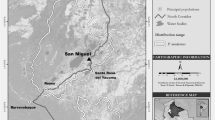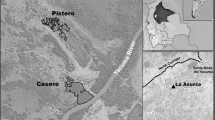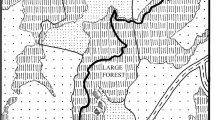Abstract
Comparisons of the behavior and ecology of primates living in intact and fragmented forest are critical to the development of conservation strategies for the many primate taxa threatened by habitat loss. From July 2009 to April 2010, we investigated the habitat use, ranging behavior, and diet of two groups of Boutourlini’s blue monkeys (Cercopithecus mitis boutourlinii), a subspecies endemic to western Ethiopia, whose habitats had experienced different levels of disturbance at Jibat Forest. Forest Group occupied primarily continuous tree-dominated forest with little human disturbance whereas Fragment Group inhabited a heavily degraded 2- to 3-km2 forest fragment nearly surrounded by farmland and connected tenuously to the continuous forest by a narrow corridor of riverine forest. Mean daily path lengths for both groups were nearly identical (Forest Group: 799 m; Fragment Group: 783 m) and exhibited little seasonal variability. The mean home range areas of Forest Group and Fragment Group were 72.0 and 61.2 ha, respectively. Forest Group (N = 2232 feeding records) fed mostly on fruits (52.5 %), though they also ate animal prey (14.7 %), young leaves (11.1 %), shoots (8.7 %), and flowers (7.3 %). In contrast, fruits accounted for only 17.0 % of Fragment Group’s diet (N = 2903 feeding records), with shoots (29.8 %), young leaves (17.1 %), animal prey (13.1 %), seeds (9.6 %), and flowers (6.8 %) also making substantial contributions to their diet. Only Fragment Group engaged in crop raiding, consuming seeds from barley and wheat extensively (33–41 % of diet) during 2 mo. Fragment Group (N = 33) ate more plant species than Forest Group (N = 24), though both groups exploited a small number of plant species relative to other subspecies of blue monkeys. Our study revealed that, like most other blue monkey subspecies, Boutourlini’s blue monkeys are quite flexible in the habitats they occupy as well as in their foraging habits. Despite this ecological flexibility, the long-term conservation of Boutourlini’s blue monkey is far from assured given its limited distribution, the rapidly growing human population, and the high rates of forest clearance in western Ethiopia.

Similar content being viewed by others
References
Altmann, J. (1974). Observational study of behaviour: sampling methods. Behaviour, 49, 227–267.
Anderson, J., Rowcliffe, J. M., & Cowlishaw, G. (2007). Does the matrix matter? A forest primate in a complex agricultural landscape. Biological Conservation, 135, 212–222.
Andren, H. (1994). Effects of habitat fragmentation on birds and mammals in landscapes with different proportions of suitable habitat: a review. Oikos, 71, 355–366.
Beeson, M. (1987). The origins of bark-stripping by blue monkeys (Cercopithecus mitis): implications for management. Zoological Journal of the Linnean Society, 91, 265–291.
Beeson, M., Tame, S., & Lea, S. E. G. (1996). Food habits of guenons (Cercopithecus spp.) in Afro-montane forest. African Journal of Ecology, 34, 202–210.
Bekele, T. (1994). Phytosociology and ecology of a humid Afromontane forest of the Central Plateau of Ethiopia. Journal of Vegetation Science, 5, 87–98.
Beyer, H. L. (2004). Hawth’s analysis tools for ArcGIS. Available at: http://www.spatialecology.com/htools. Accessed 01 May 2010.
Bicca-Marques, J. C. (2003). How do howler monkeys cope with habitat fragmentation? In L. K. Marsh (Ed.), Primates in fragments: ecology and conservation (pp. 283–303). New York: Kluwer Academic/ Plenum Press.
BirdLife International (2009). Important bird area fact sheet: Jibat Forest, Ethiopia. Available at: http://www.birdlife.org/. Accessed 29 Oct 2012.
Boyle, S. A. (2008). The effects of forest fragmentation on primates in the Brazilian Amazon. Ph.D. dissertation, Department of Anthropology, Arizona State University.
Boyle, S. A. (2012). Implications of habitat fragmentation on the diet of bearded saki monkeys in central Amazonian forest. Journal of Mammalogy, 93, 959–976.
Butynski, T. M. (1990). Comparative ecology of blue monkeys (Cercopithecus mitis) in high- and low-density subpopulations. Ecological Monographs, 60, 1–26.
Butynski, T. M., & Gippoliti, S. (2008). Cercopithecus mitis ssp. boutourlinii. In IUCN 2012. IUCN Red List of Threatened Species. Version 2012.1. Available at: www.iucnredlist.org. Accessed 26 July 2012.
Campbell-Smith, G., Simanjorang, H. V., Leader-Williams, N., & Linkie, M. (2010). Local attitudes and perceptions toward crop-raiding by orangutans (Pongo abelii) and other nonhuman primates in northern Sumatra, Indonesia. American Journal of Primatology, 72, 866–876.
Campbell-Smith, G., Campbell-Smith, M., Singleton, I., & Linkie, M. (2011). Apes in space: imperiled orangutan population in Sumatra. PloS One, 6, e17210.
Chapman, C. A., & Chapman, L. J. (1999). Forest restoration in abandoned agricultural land: a case study from East Africa. Conservation Biology, 13, 1301–1311.
Chapman, C. A., & Chapman, L. J. (2002). Foraging challenges of red colobus monkeys: influence of nutrients and secondary compounds. Comparative Biochemistry and Physiology, 133, 861–875.
Chapman, C. A., Lawes, M. J., & Eeley, H. A. C. (2006a). What hope for African primate diversity? African Journal of Ecology, 44, 116–133.
Chapman, C. A., Wasserman, M. D., Gillespie, T. R., Speirs, M. L., Lawes, M. J., & Ziegler, T. E. (2006b). Do nutrition, parasitism, and stress have synergistic effects on red colobus populations living in forest fragments? American Journal of Physical Anthropology, 131, 525–534.
Chapman, C. A., Naughton-Treves, L., Lawes, M. J., Wasserman, M. D., & Gillespie, T. R. (2007). Population declines of colobus in western Uganda and conservation value of forest fragments. International Journal of Primatology, 28, 513–528.
Chatelain, C., Gautier, L., & Spichiger, R. (1996). A recent history of forest fragmentation in southwestern Ivory Coast. Biodiversity and Conservation, 5, 37–53.
Cords, M. (1986). Interspecific and intraspecific variation in diet of two forest guenons. Cercopithecus ascanius and C. mitis. Journal of Animal Ecology, 55, 811–827.
Cords, M. (1987). Mixed-species association of Cercopithecus monkeys in the Kakamega Forest, Kenya. University of California, Publications in Zoology, 117, 1–109.
Cristóbal-Azkarate, J., & Arroyo-Rodríguez, V. (2007). Diet and activity pattern of howler monkeys (Alouatta palliata) in Los Tuxtlas, Mexico: effects of habitat fragmentation and implications for conservation. American Journal of Primatology, 69, 1013–1029.
Dunbar, R. I. M. (1987). Habitat quality, population dynamics, and group composition in colobus monkeys (Colobus guereza). International Journal of Primatology, 8, 299–329.
Eniang, E. A. (2003). Effects of habitat fragmentation on the Cross River gorilla (Gorilla gorilla diehli): recommendations for conservation. In L. K. Marsh (Ed.), Primates in fragments: ecology and conservation (pp. 343–363). New York: Kluwer Academic/Plenum Press.
Estrada, A., & Coates-Estrada, R. (1996). Tropical rain forest fragmentation and wild populations of primates at Los Tuxtlas, Mexico. International Journal of Primatology, 17, 759–783.
Fairgrieve, C., & Muhumuza, G. (2003). Feeding ecology and dietary differences between blue monkey (Cercopithecus mitis stuhlmanni Matschie) groups in logged and unlogged forest, Budongo Forest Reserve, Uganda. African Journal of Ecology, 41, 141–149.
Fashing, P. J. (2001a). Activity and ranging patterns of guerezas in the Kakamega Forest: intergroup variation and implications for intragroup feeding competition. International Journal of Primatology, 22, 549–577.
Fashing, P. J. (2001b). Feeding ecology of guerezas in the Kakamega Forest, Kenya: the importance of Moraceae fruit in their diet. International Journal of Primatology, 22, 579–609.
Fashing, P. J., & Gathua, J. M. (2004). Spatial variability in the vegetation structure and composition of an East African rain forest. African Journal of Ecology, 42, 189–197.
Felton, A. M., Felton, A., Wood, J. T., & Lindenmayer, D. B. (2008). Diet and feeding ecology of Ateles chamek in a Bolivian semihumid forest: the importance of Ficus as a staple food resource. International Journal of Primatology, 29, 379–403.
Gautier-Hion, A., & Michaloud, G. (1989). Are figs always keystone resources for tropical frugivorous vertebrates? A test in Gabon. Ecology, 70, 1826–1833.
Grubb, P., Butynski, T. M., Oates, J. F., Bearder, S. K., Disotell, T. R., Groves, C. P., et al. (2003). Assessment of the diversity of African primates. International Journal of Primatology, 24, 1301–1357.
Harrison, S., & Bruna, E. (1999). Habitat fragmentation and large-scale conservation: what do we know for sure? Ecography, 22, 225–232.
Hill, C. M. (1997). Crop-raiding by wild vertebrates: the farmer’s perspective in an agricultural community in western Uganda. International Journal of Pest Management, 43, 77–84.
Hill, C. M. (2000). A conflict of interest between people and baboons: crop raiding in Uganda. International Journal of Primatology, 21, 299–315.
Isabirye-Basuta, G. M., & Lwanga, J. S. (2008). Primate populations and their interactions with changing habitats. International Journal of Primatology, 29, 35–48.
IUCN 2012. The IUCN Red List of Threatened Species. Version 2012.2. Available at: http://www.iucnredlist.org. Accessed 22 Feb 2013.
Jaffe, K. E., & Isbell, L. A. (2011). The guenons: polyspecific associations in socioecological perspective. In C. J. Campbell, A. Fuentes, K. C. Mackinnon, S. K. Bearder, & R. M. Stumpf (Eds.), Primates in perspective (pp. 277–300). New York: Oxford University Press.
Jennrich, R. I., & Turner, F. B. (1969). Measurements of non-circular home range. Journal of Theoretical Biology, 22, 227–237.
Kaplin, B. A. (2001). Ranging behavior of two species of guenons (Cercopithecus lhoesti and C. mitis doggetti) in the Nyungwe Forest Reserve, Rwanda. International Journal of Primatology, 22, 521–548.
Kaplin, B. A., & Moermond, T. C. (2000). Foraging ecology of the mountain monkey (Cercopithecus l’hoesti): implications for its evolutionary history and use of disturbed forest. American Journal of Primatology, 50, 227–246.
Kaplin, B. A., Munyaligoga, V., & Moermond, T. C. (1998). The influence of temporal changes in fruit availability on diet composition and seed handling in blue monkey (Cercopithecus mitis doggetti). Biotropica, 30, 56–71.
Kingdon, J., Gippoliti, S., Butynski, T. M., Lawes, M. J., Eeley, H., & Lehn, C. (2008). Cercopithecus mitis. In IUCN 2012. IUCN Red List of Threatened Species. Version 2012.1. Available at: www.iucnredlist.org. Accessed 26 July 2012.
Krebs, C. J. (1989). Ecological methodology. London: Harper Collins.
Laurance, W. F., Ferreira, L. V., Rankin-de Merona, J. M., & Laurance, S. G. (1998). Rain forest fragmentation and the dynamics of Amazonian tree communities. Ecology, 79, 2032–2040.
Lawes, M. J. (1990). The distribution of the Samango monkey (Cercopithecus mitis erythrarchus Peters, 1852 and Cercopithecus mitis labiatus I. Geoffroy, 1843) and forest history in southern Africa. Journal of Biogeography, 17, 669–680.
Lawes, M. J. (1991). Diet of samango monkeys (Cercopithecus mitis erythrarchus) in the Cape Vidal dune forest, South Africa. Journal of Zoology (London), 224, 149–173.
Lawes, M. J. (2002). Conservation of fragmented populations of Cercopithecus mitis in South Africa: The role of reintroduction, corridors and metapopulation ecology. In M. Glenn & M. Cords (Eds.), The guenons: Diversity and adaptation in African monkeys (pp. 375–392). New York: Kluwer Academic/Plenum Press.
Lawes, M. J., Mealin, P. E., & Piper, S. E. (2000). Patch occupancy and potential metapopulation dynamics of three forest mammals in fragmented Afromontane forest in South Africa. Conservation Biology, 14, 1088–1098.
Lee, P. C., & Priston, N. E. C. (2005). Perception of pests: human attitudes to primates, conflict and consequences for conservation. In J. D. Paterson & J. Wallis (Eds.), Commensalism and conflict: The human-primate interface (pp. 1–23). Norman: American Society of Primatologists.
Marsh, L. K. (2003). Primates in fragments: Ecology and conservation. New York: Kluwer Academic/Plenum Press.
Marshall, A. J., Boyko, C. M., Feilen, K. L., Boyko, R. H., & Leighton, M. (2009). Defining fallback foods and assessing their importance in primate ecology and evolution. American Journal of Physical Anthropology, 140, 603–614.
Martinez-Mota, R., Valdespino, C., Sánchez-Ramos, M. A., & Serio-Silva, J. C. (2007). Effects of forest fragmentation on the physiological stress response of black howler monkeys. Animal Conservation, 10, 374–279.
Mekonnen, A., Bekele, A., Fashing, P. J., Hemson, G., & Atickem, A. (2010). Diet, activity patterns, and ranging ecology of the Bale monkey (Chlorocebus djamdjamensis) in Odobullu Forest, Ethiopia. International Journal of Primatology, 31, 339–362.
Mekonnen, A., Bekele, A., Fashing, P. J., Lernould, J.-M., Atickem, A., & Stenseth, N. C. (2012). Newly discovered Bale monkey populations in forest fragments in southern Ethiopia: evidence of crop raiding, hybridization with grivets, and other conservation threats. American Journal of Primatology, 74, 423–432.
Onderdonk, D. A., & Chapman, C. A. (2000). Coping with forest fragmentation: the primates of Kibale National Park, Uganda. International Journal of Primatology, 21, 587–611.
Parr, N. A., Melin, A. D., & Fedigan, L. M. (2011). Figs are more than fallback foods: the relationship between Ficus and Cebus in a tropical dry forest. International Journal of Zoology. doi:10.1155/2011/967274.
Pazol, K., & Cords, M. (2005). Seasonal variation in feeding behavior, competition and female social relationships in a forest dwelling guenon, the blue monkeys (Cercopithecus mitis stuhlmanni), in the Kakamega Forest, Kenya. Behavioral Ecology and Sociobiology, 58, 566–577.
Plumptre, A. J. (2006). The diets, preferences, and overlap of the primate community in the Budongo Forest Reserve, Uganda: effects of logging on primate diets. In N. Newton-Fisher, H. Notman, J. D. Paterson, & V. Reynolds (Eds.), Primates of western Uganda (pp. 345–371). New York: Springer.
Putz, S., Groeneveld, J., Alves, L. F., Metzger, J. P., & Huth, A. (2011). Fragmentation drives tropical forest fragments to early successional states: a modeling study for Brazilian Atlantic forests. Ecological Modelling, 222, 1986–1997.
Riitters, K., Wickham, J., O’Neill, R., Jones, B., & Smith, E. (2000). Global-scale patterns of forest fragmentation. Conservation Ecology, 4, 3. Available at: http://www.consecol.org/vol4/iss2/art3/. Accessed 12 Nov 2012.
Rudran, R. (1978). Socioecology of the blue monkeys (Cercopithecus mitis stuhlmanni) of the Kibale Forest, Uganda. Smithsonian Contributions to Biology, 249, 1–88.
Schlichte, H.-J. (1978). The ecology of two groups of blue monkeys in an isolated habitat of poor vegetation. In G. G. Montgomery (Ed.), The ecology of arboreal folivores (pp. 505–517). Washington, DC: Smithsonian Institution Press.
Schoener, T. W. (1981). An empirically based estimate of home range. Theoretical Population Biology, 20, 281–325.
Shanahan, M., Sampson, S. O., Compton, S. G., & Corlett, R. (2001). Fig-eating by vertebrate frugivores: a global review. Biological Reviews of the Cambridge Philosophical Society, 76, 529–272.
Souza, A. F., Cortez, L. S. R., & Longhi, S. J. (2012). Native forest management in subtropical South America: long-term effects of logging and multiple-use on forest structure and diversity. Biodiversity and Conservation, 21, 1953–1969.
State Forests Conservation and Development Department (SFCDD). (1990). Ethiopian forest resource base identification, conservation and rational use in Ethiopia. Addis Ababa: SFCDD.
Struhsaker, T. T. (1997). Ecology of an African rain forest: Logging in Kibale and the conflict between conservation and exploitation. Gainesville: University Press of Florida.
Strum, S. C. (2010). The development of primate raiding: implications for management and conservation. International Journal of Primatology, 31, 133–156.
Swart, J., & Lawes, M. J. (1996). The effect of habitat patch connectivity on samango monkey (Cercopithecus mitis) metapopulation persistence. Ecological Modelling, 93, 57–74.
Swedell, L. (2011). African papionins: diversity of social organization and ecological flexibility. In C. J. Campbell, A. Fuentes, K. C. Mackinnon, S. K. Bearder, & R. M. Stumpf (Eds.), Primates in perspective (pp. 241–277). New York: Oxford University Press.
Tesfaye, D. (2010). Ecology, behaviour and conservation of Boutourlini’s blue monkey (Cercopithecus mitis boutourlinii) in the Jibat Forest, Ethiopia. MSc thesis, Department of Biology, Addis Ababa University.
Turner, I. M. (1996). Species loss in fragments of tropical rain forest: a review of the evidence. Journal of Applied Ecology, 33, 200–209.
Tutin, C. E. G. (1999). Fragmented living: behavioural ecology of primates in a forest fragment in the Lopé Reserve, Gabon. Primates, 40, 249–265.
Twinomugisha, D., & Chapman, C. A. (2008). Golden monkey ranging in relation to spatial and temporal variation in food availability. African Journal of Ecology, 46, 585–593.
Twinomugisha, D., Chapman, C. A., Lawes, M. J., O’Driscoll Worman, C., & Danish, L. M. (2006). How does the golden monkey of the Virungas cope in a fruit-scarce environment? In N. E. Newton-Fisher, H. Notman, J. D. Paterson, & V. Reynolds (Eds.), Primates of Western Uganda (pp. 45–60). New York: Springer.
Vié, J., Richard-Hansen, C., & Fournier-Chambrillon, C. (2001). Abundance, use of space and activity pattern of white faced sakis (Pithecia pithecia) in French Guiana. American Journal of Primatology, 55, 203–221.
Wallace, R. B. (2006). Seasonal variations in black-faced black spider monkey (Ateles chamek) habitat use and ranging behavior in a southern Amazonian tropical forest. American Journal of Primatology, 68, 313–332.
Wong, S. N. P., & Sicotte, P. (2007). Activity budget and ranging patterns of Colobus vellerosus in forest fragments in Central Ghana. Folia Primatologica, 78, 245–254.
Worton, B. J. (1987). A review of models of home range for animal movement. Ecological Modeling, 38, 277–298.
Yalden, D. W., Largen, M. J., & Kock, D. (1977). Catalogue of the mammals of Ethiopia. 3. Primates. Monitore Zoologico Italiano, 1, 1–52.
Acknowledgments
This research was funded by Primate Conservation, Inc. (PCI) and by the Department of Zoological Sciences at Addis Ababa University. We thank the Department of Zoological Sciences at Addis Ababa University for logistical support and the Ethiopian Wildlife Conservation Authority, Finfine Forest Development Enterprise, and Jibat Forest Enterprise for permission to conduct this research. We thank Assefa Hailu of the National Herbarium of Addis Ababa University for identification of plant specimens. We also thank Nga Nguyen for assistance with the statistical analyses and for creating Fig. 1. This research would not have been possible without our field assistants, camp attendants, and local guides.
Author information
Authors and Affiliations
Corresponding authors
Rights and permissions
About this article
Cite this article
Tesfaye, D., Fashing, P.J., Bekele, A. et al. Ecological Flexibility in Boutourlini’s Blue Monkeys (Cercopithecus mitis boutourlinii) in Jibat Forest, Ethiopia: A Comparison of Habitat Use, Ranging Behavior, and Diet in Intact and Fragmented Forest. Int J Primatol 34, 615–640 (2013). https://doi.org/10.1007/s10764-013-9684-x
Received:
Accepted:
Published:
Issue Date:
DOI: https://doi.org/10.1007/s10764-013-9684-x




